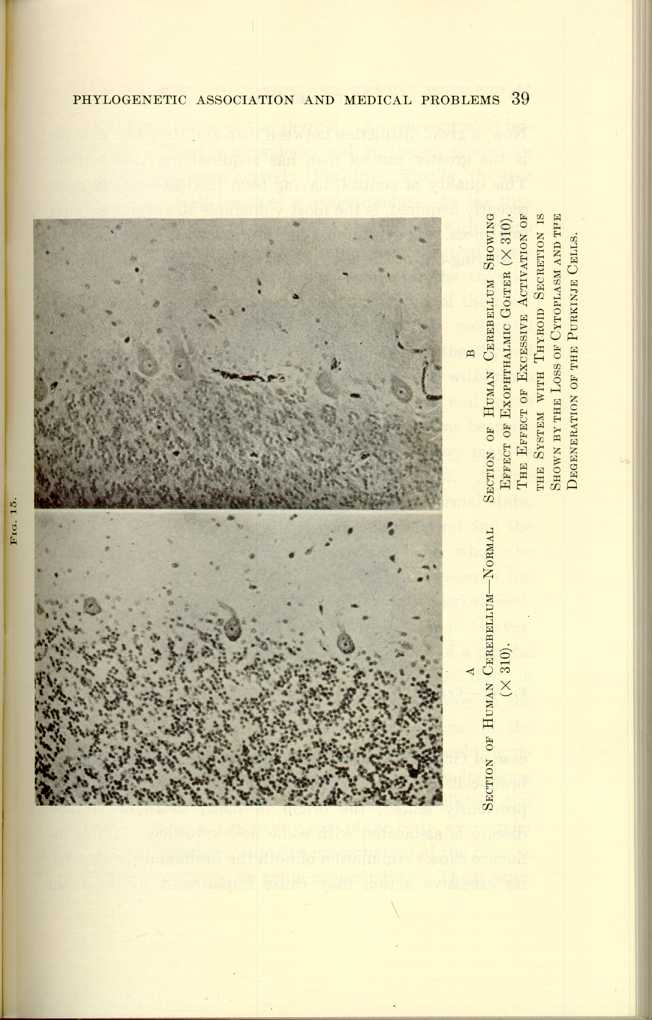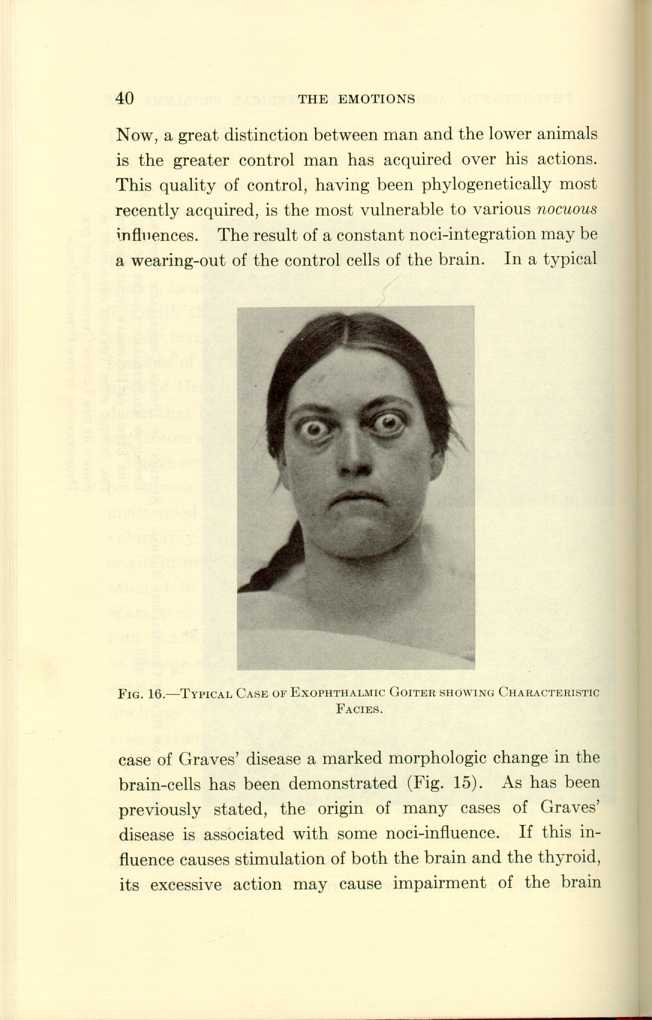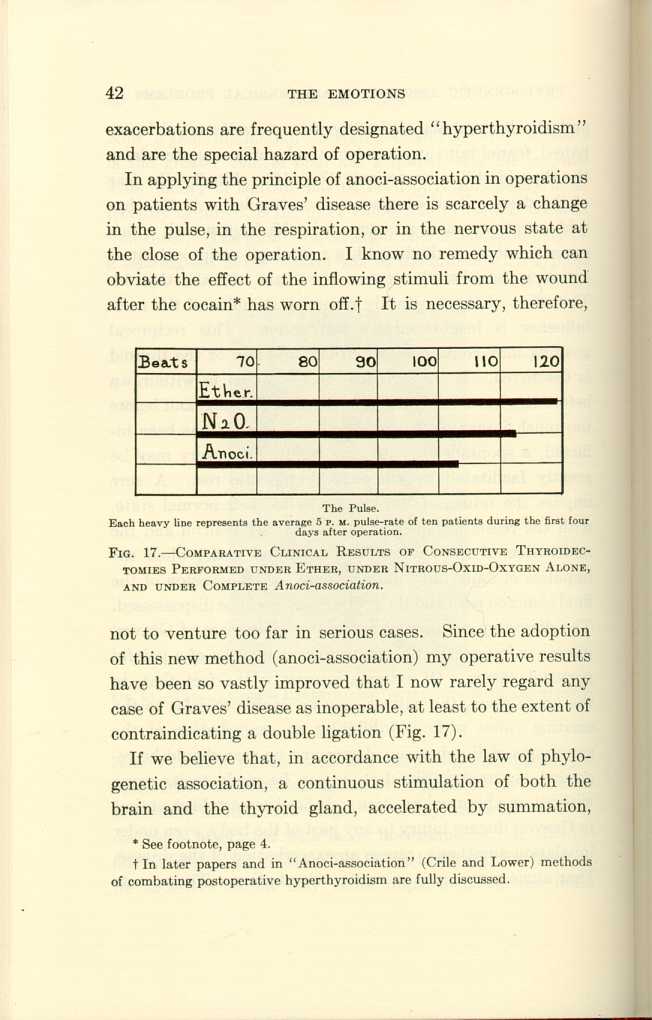| The Origin and Nature of the Emotions: Miscellaneous Papers | ||
Graves' Disease
By applying the principle of the discharge of nervous energy by phylogenetic association, and by making the
In the wild state of animal life in which only the fittest survive in the struggle for existence, every point of advantage has its value. An animal engaged in battle or in a desperate effort to escape will be able to give a better account of itself if it have some means of accelerating the discharge of energy—some influence like that of pouring oil upon the kindling fire. There is evidence, though perhaps it is not conclusive, that such an influence is exerted by the thyroid gland. In myxedema, a condition characterized by a lack of thyroid secretion, there is dulness of the reflexes and of the intellect, a lowered muscular power, and generally a sluggish discharge of energy. In Graves' disease there is an excessive production of thyroid secretion. In this disease the reflexes are increased, the discharge of energy is greatly facilitated, and metabolism is at a maximum. The same phenomena occur also after the administration of thyroid extract in large doses to normal subjects. In the course of sexual activities there is an increased action of the thyroid, which is indicated by an increase in its size and vascularity. That in fear and in injury the thyroid, in cases of Graves' disease, is probably stimulated to increased activity is indicated by the increased activity of the thyroid circulation, by an increase in the size of the gland, by the histologic appearance of activity in the nuclei of the cells, and by an increase of the toxic symptoms. Finally, Asher has stated that electric stimulation of the nerve supply of the thyroid causes an increased secretion.
I have never known a case of Graves' disease to be caused by success or happiness alone, or by hard physical labor unattended by psychic strain, or to be the result of energy voluntarily discharged. Some cases seem to have had their origin in overdosage with thyroid extract in too vigorous an attempt to cure a colloid goiter. One of the most striking characteristics of Graves' disease is the patient's loss of control and his increased susceptibility to stimuli, especially to trauma and to fear and to the administration of thyroid extract. It has been shown that the various causes of the discharge of nervous energy produce alterations in the nervous system and probably in the thyroid gland. This is especially true of the fear stimulus, and has been clearly demonstrated in the brains of rabbits which had been subjected to fear alone (Fig. 13). Of special interest was the effect of daily fright. In this case the brain-cells showed a distinct change, although the animal had been subjected to no fear for twenty-four hours before it was killed (Fig. 13 C.

FIG. 15
A: Section of Human Cerebellum—Normal (x310).
B: Section of Human Cerebellum Showing Effect of Exophthalmic Goiter
(x310). The Effect of Excessive Activation of the System with Thyroid
Secretion is Shown by the Loss of Cytoplasm and the Degeneration of the
Purkinje Cells.
[Description: Black-and-white photographs showing sections of human
cerebellum under various conditions.]

FIG. 16—TYPICAL CASE OF EXOPHTHALMIC GOITER SHOWING CHARACTERISTIC FACIES.
[Description: Black-and-white photograph of woman with bulging eyes.]In applying the principle of anoci-association in operations on
patients with Graves' disease there is scarcely a change in the pulse,
in the respiration, or in the nervous state at the close of the
operation. I know no remedy which can obviate the effect of the
inflowing stimuli from the wound after the
cocain[7] has worn
off.[8] It is necessary,
therefore,

The Pulse.
[Description: Black-and-white illustration: bar graph.]
Each heavy line represents the average 5 P. M. pulse-rate of ten
patients during the first four days after operation.
FIG. 17.—COMPARATIVE CLINICAL RESULTS OF CONSECUTIVE THYROIDECTOMIES
PERFORMED UNDER ETHER, UNDER NITROUS-OXID-OXYGEN ALONE,
AND UNDER COMPLETE Anoci-association.
If we believe that, in accordance with the law of phylogenetic association, a continuous stimulation of both the brain and the thyroid gland, accelerated by summation,
| The Origin and Nature of the Emotions: Miscellaneous Papers | ||